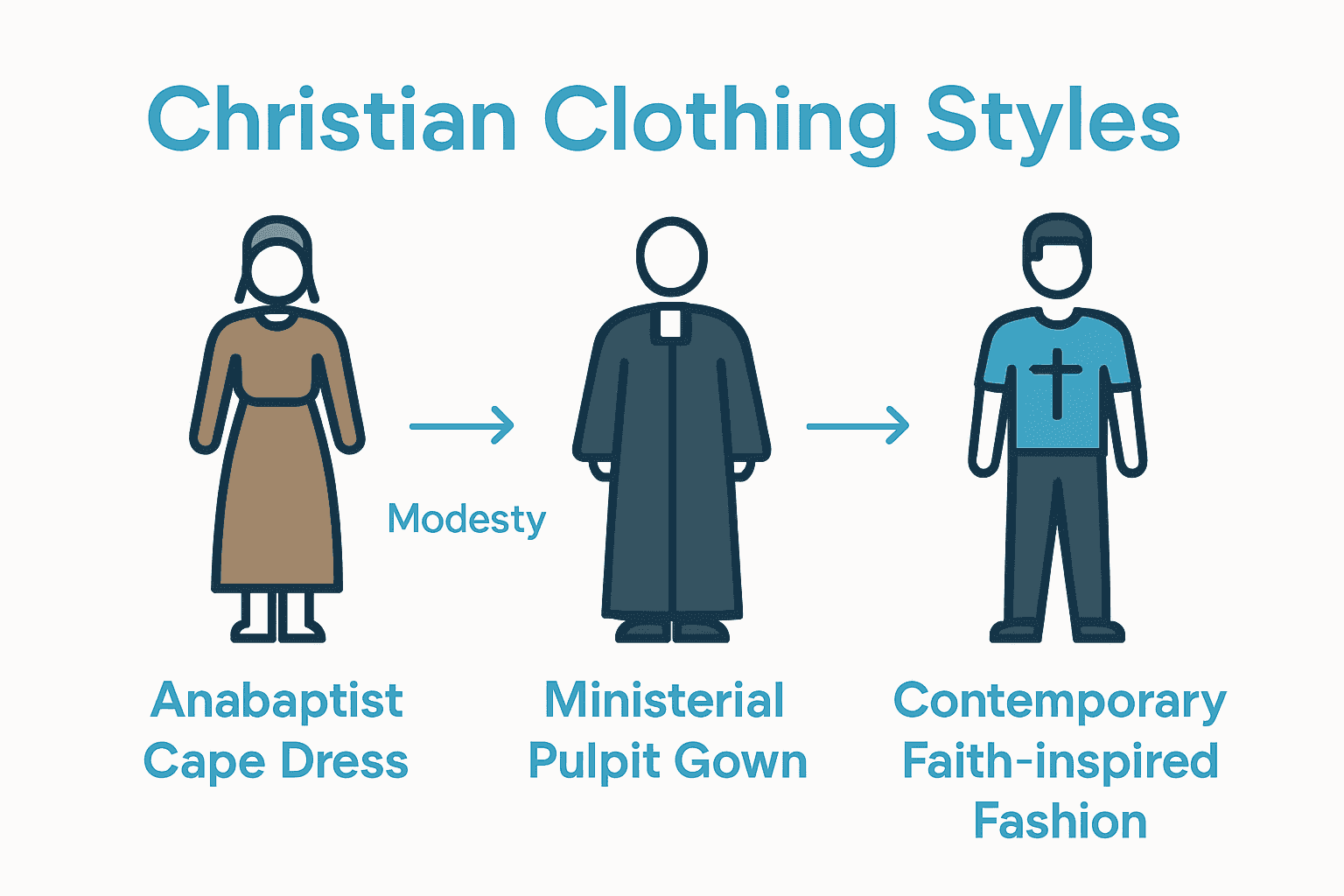Nearly 60 percent of Christians say their clothing choices reflect their spiritual beliefs every day. What you wear can quietly reveal your values long before you speak a word. Faith-based wardrobes are rooted in principles like modesty and dignity, helping believers align their outward appearance with inner convictions. This guide shows how Christian values shape clothing, explores distinct styles, and offers insight for anyone seeking meaningful ways to express faith through daily dress.
Table of Contents
- Faith-Based Wardrobe: Definition And Principles
- Major Styles In Christian Clothing Choices
- How Faith Influences Everyday Wardrobe Selection
- Symbolism And Meaning In Faith-Inspired Attire
- Practical Tips And Common Mistakes To Avoid
Key Takeaways
| Point | Details |
|---|---|
| Faith-Based Wardrobe Definition | Reflects a commitment to expressing Christian values through modest and respectful clothing choices. |
| Core Principles | Emphasizes dignity, modesty, and an alignment of external appearance with internal spiritual beliefs. |
| Diversity in Styles | Includes various denominational interpretations that cater to both traditional and contemporary expressions of faith. |
| Practical Implementation | Mindful selections should prioritize spiritual principles over trends, balancing personal style with faith commitments. |
Faith-Based Wardrobe: Definition And Principles
A faith-based wardrobe represents more than just clothing selections; it embodies a personal commitment to expressing Christian values through intentional dress choices. According to tfp.org, what we wear can profoundly communicate our spiritual convictions and societal aspirations.
The fundamental principles of a faith-based wardrobe center on modesty, dignity, and respect. This approach goes beyond simply covering one’s body and instead focuses on clothing that honors God and reflects inner spiritual character. Some key characteristics include:
- Garments that promote dignity and self-respect
- Clothing that avoids drawing inappropriate attention
- Styles that demonstrate personal integrity
- Selections that align with biblical standards of presentation

Historically, different Christian traditions have interpreted modest dress uniquely. Wikipedia provides an excellent example through the Anabaptist cape dress, which features a double-layered bodice and long skirt designed to conceal bodily form while maintaining elegance and spiritual purpose. This tradition demonstrates how clothing can be both functional and a powerful expression of faith.
Ultimately, a faith-based wardrobe is a personal journey of aligning external appearance with internal spiritual beliefs. Learn more about Christian clothing choices in our guide on faith-based apparel.
Major Styles In Christian Clothing Choices
Christian clothing styles represent a diverse and meaningful expression of faith, reflecting various denominational traditions and personal spiritual convictions. These styles range from traditional modest attire to contemporary interpretations that balance spiritual principles with modern fashion sensibilities.
Here’s a comparison of major Christian clothing styles and their core features:
| Tradition or Style | Key Characteristics | Symbolic Meaning |
|---|---|---|
| Anabaptist (Cape Dress) | Double-layered bodice Long skirt Simple |
Modesty Humility |
| Ministerial Attire | Black pulpit/geneva gown Formal |
Spiritual office Academic training |
| Conservative Mennonite | Long dresses Head coverings Muted colors |
Simplicity Communal identity |
| Contemporary Christian | Modern cuts Faith symbols/messages |
Personal testimony Relatability |
| Liturgical Vestments | Robes and stoles Rich materials Colors |
Sacred role Liturgical symbolism |
Denominational Clothing Styles highlight the rich diversity within Christian dress traditions:
-
Anabaptist Tradition: Wikipedia showcases the iconic cape dress, a quintessential example of modest Christian clothing. Characterized by a double-layered bodice and long skirt, this garment symbolizes humility and spiritual commitment.
-
Ministerial Attire: Wikipedia describes the pulpit gown, or Geneva gown, worn by Protestant ministers. This black robe emphasizes the spiritual office and academic training, transcending individual personality.
-
Conservative Mennonite Style: Long dresses, head coverings, and muted colors that prioritize modesty and simplicity
-
Contemporary Christian Fashion: Clothing that subtly incorporates faith-based symbols or messages
-
Liturgical Vestments: Specialized clothing worn by clergy during religious services
Modern Christian clothing has evolved to embrace both tradition and contemporary design.
While maintaining core principles of modesty and respect, today’s faith-based wardrobes offer more flexibility and personal expression. Explore the nuanced world of Christian clothing styles in our comprehensive guide.
How Faith Influences Everyday Wardrobe Selection
Faith profoundly transforms wardrobe selection from a mere fashion choice to a deeply personal spiritual expression. tfp.org highlights how clothing becomes a powerful medium for communicating Christian values and personal convictions in everyday life.
Core Principles of Faith-Driven Clothing Choices include:
- Reflecting inner spiritual character through external appearance
- Demonstrating respect for one’s body as a sacred temple
- Prioritizing modesty and dignity over trendy or provocative styles
- Expressing commitment to biblical teachings through thoughtful attire
Historically, different Christian traditions have interpreted this spiritual clothing philosophy uniquely. Wikipedia provides a compelling example through the Anabaptist cape dress, which symbolizes a profound commitment to modesty and biblical principles. This garment isn’t just clothing - it’s a visual testimony of faith, showing how deeply spiritual beliefs can influence personal style.
Modern Christian fashion allows for more individual interpretation while maintaining core spiritual values. Believers now have greater flexibility to express faith through clothing that feels authentic to their personal style and denominational background. Discover more about faith-inspired fashion choices in our comprehensive guide.
Symbolism And Meaning In Faith-Inspired Attire
Faith-inspired attire transcends mere clothing, serving as a profound visual language that communicates spiritual beliefs, personal convictions, and denominational affiliations. Every garment becomes a canvas for expressing deeper theological meanings and personal spiritual journeys.
Symbolic Elements in Religious Clothing reveal intricate layers of spiritual significance:
- Colors representing theological concepts
- Patterns echoing biblical narratives
- Designs reflecting spiritual disciplines
- Materials symbolizing humility and simplicity
Wikipedia) provides an excellent example through liturgical vestments like the stole, a long, narrow cloth band that symbolizes priestly authority and spiritual calling. These garments are not just accessories but powerful representations of sacred responsibilities and spiritual roles.
Some Christian traditions embrace more extreme forms of symbolic attire. Wikipedia describes the cilice, a garment worn as a means of spiritual discipline and personal sacrifice, demonstrating how clothing can be a physical expression of spiritual devotion and personal transformation.
Modern faith-inspired fashion continues this rich tradition of meaningful dress, allowing believers to express their spiritual identity through thoughtful wardrobe choices. Explore the deeper values behind Christian clothing in our comprehensive guide.
Practical Tips And Common Mistakes To Avoid
Creating a faith-based wardrobe requires thoughtful consideration and intentional choices that balance personal style with spiritual principles. Navigating this journey can be challenging, but understanding key guidelines helps believers make confident clothing decisions that honor their faith.
Common Mistakes to Sidestep:
- Prioritizing trend over modesty
- Ignoring denominational clothing guidelines
- Misunderstanding the difference between personal style and spiritual expression
- Overcorrecting into overly restrictive clothing choices
Wikipedia offers valuable insights into appropriate dress standards, particularly for significant religious events. The guidelines emphasize key principles such as maintaining modest necklines, ensuring appropriate skirt lengths, and avoiding overly revealing or attention-seeking garments.
Wikipedia further illustrates the importance of adhering to specific community standards, highlighting that faith-based clothing is not just about individual preference but also about respecting collective spiritual traditions. When selecting clothing, consider how your choices reflect not just personal style, but your commitment to your faith community.
Ultimately, building a faith-based wardrobe is a personal journey of self-expression and spiritual alignment. Discover more essential tips for faith-inspired fashion choices in our comprehensive guide.
Elevate Your Faith-Based Wardrobe with Purpose and Style
Choosing clothing that truly reflects your Christian values can be a challenge. The article highlights how a faith-driven wardrobe requires intentional choices rooted in modesty, dignity, and spiritual symbolism. You want garments that express your commitment without sacrificing comfort or elegance. You also need options that honor both your personal style and your faith traditions.

At Walk In His Footsteps, we understand the importance of aligning your outward appearance with your inner beliefs. Our patented cross bottom and Jesus fish bottom slip-on footwear offer unique designs that seamlessly blend faith-inspired symbolism with everyday wearability. Take control of your wardrobe today and express your spirituality through meaningful fashion choices. Explore our faith-inspired apparel and discover how to build a wardrobe that honors your spiritual journey. Start now by visiting Walk In His Footsteps and learn how to wear your faith every step of the way.
Frequently Asked Questions
What is a faith-based wardrobe?
A faith-based wardrobe is a collection of clothing that reflects Christian values through intentional choices. It focuses on modesty, dignity, and respect while aligning external appearance with inner spiritual beliefs.
How does faith influence clothing choices?
Faith influences clothing choices by emphasizing modesty and dignity over trending styles. Clothing becomes a medium for expressing personal convictions and commitment to biblical teachings, allowing for individuality while adhering to spiritual standards.
What are common styles in Christian clothing choices?
Common styles in Christian clothing include Anabaptist attire (such as the cape dress), ministerial garb like the pulpit gown, conservative Mennonite outfits, contemporary Christian fashion, and liturgical vestments. Each style has unique characteristics that reflect different spiritual traditions.

What mistakes should I avoid when building a faith-based wardrobe?
Common mistakes to avoid include prioritizing trends over modesty, neglecting denominational guidelines, misunderstanding personal style versus spiritual expression, and overcorrecting to overly restrictive clothing choices. It’s essential to find a balance that respects both faith and personal expression.
Recommended
- What Is Faith-Based Apparel? Complete Guide for Christians – Walk In His Footsteps
- Faith Inspired Fashion: Complete Guide for Christians – Walk In His Footsteps
- 7 Essential Tips for Your Faith-Based Fashion Checklist – Walk In His Footsteps
- Understanding the Guide to Faith-Based Clothing – Walk In His Footsteps




